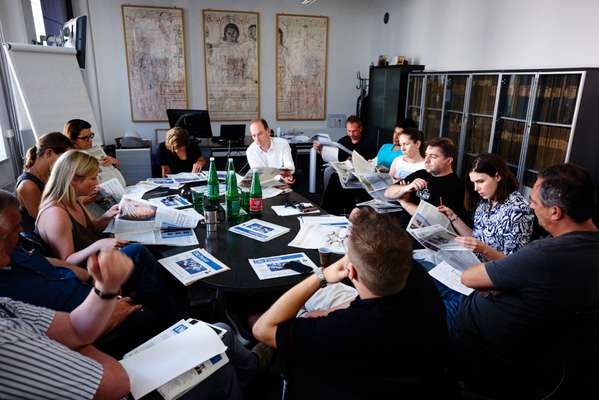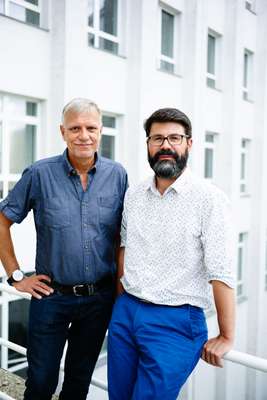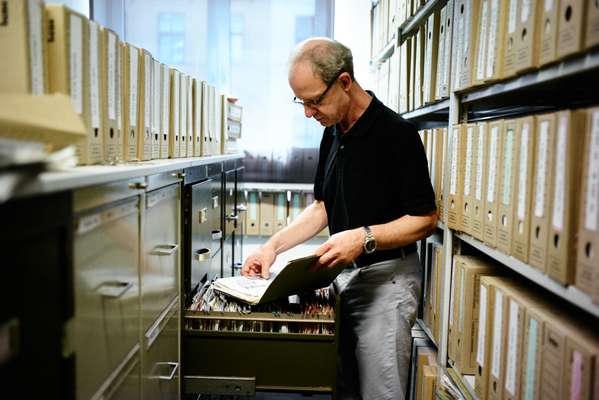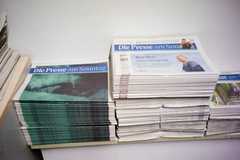Report / Vienna
News School
Despite challenging times for many newspapers, Austria’s ‘Die Presse’ newspaper has kept faith with the training programme it founded nearly 50 years ago. Today half its staff are alumni and the paper’s investment in talent is paying off – in sales.
It’s a sunny Tuesday in Vienna and the office of Die Presse, the capital’s premiere daily newspaper, is ghostly empty. That’s because it is 10.30 in the morning and everyone is either at the daily editorial meeting or braving the stifling heat covering their beat. It is the middle of the summer – generally a slow-news season – and while editor in chief Rainer Nowak is enjoying la bella vita on a well-deserved holiday in southern Italy, managing editor Friederike Leibl-Bürger is presiding over today’s meeting.
Fourteen reporters are huddled around the oval conference table in Nowak’s office, hugging cups of coffee and yesterday’s edition. “Let’s begin with the Sunday paper,” says Leibl-Bürger, looking at the co-editor of Die Presse am Sonntag, Ulrike Weiser. She takes the lead and speaks amid the rustle of pages. “Next week we would like to open the paper with a thematic plea for growing up. It could run alongside a photo of Disney’s Peter Pan on the front.”
Weiser herself grew up at Die Presse. She began her career here 13 years ago after completing her law degree and accepting a coveted place on the paper’s Lehrredaktion, the first journalism training programme of its kind in Austria. It was established by the newspaper in the 1970s with the aim of coaching a handful of talented writers and picking out the best of the bunch. Over the course of three months, Weiser learned the basics of journalism, covered stories for each section of the paper and heard lectures by editors and experts. At the end she was asked to stay.







With a readership of more than 300,000 daily, the Styria Media Group-owned Die Presse is one of Austria’s most popular quality newspapers, along with the Wiener Zeitung and Der Standard. Its much-imitated Lehrredaktion pre-dates the city’s leading communications curriculum at FHWien University of Applied Sciences of wkw and has proved more successful in helping aspiring journalists get a foot in the door.
“I was a member of the Lehrredaktion myself in 1980; it has a long tradition,” says Stefan Schöffl, who has been leading the journalism bootcamp since 1997. “In Austria anyone can become a journalist, without formal training. Whether they should is another question as jobs in print are limited.” About 400 people apply annually for the Lehrredaktion, although the programme is not set in stone and may skip a year depending on the newspaper’s recruitment needs. No more than 10 lucky candidates are granted a spot; after passing the stringent entrance exams, each pays a fee of €2,000, for which scholarships are available. “Journalism is a craft best acquired in the field,” says Schöffl, explaining that about half of Die Presse’s staff began their careers with the Lehrredaktion.
Back in the conference room, time is ticking as the team turns its attention to the daily paper, which has to be sent to the printers in less than eight hours. As the editorial team discusses the front page, a ray of sunlight picks out a glass-fronted armoire that heaves with bound issues of Die Presse. The neatly sorted, slightly frayed newspapers date back to 1848, when Austrian press censorship was abolished and entrepreneur August Zang seized the opportunity to launch his publication. Within these volumes are the stories that made history, from reports of the murder of Franz Ferdinand in 1914 through the Wall Street Crash of 1929 to today – with a focus on the Iran nuclear deal. “There’s our front page,” says Leibl-Bürger – and with that the meeting comes to a close.
Among the reporters filing out of the room is Teresa Schaur-Wünsch, another Lehrredaktion graduate, who works for the Chronik local-news section as well as at the Sunday paper for Weiser. “I am here thanks to Die Presse am Sonntag,” says Schaur-Wünsch of the publication, established in 2009. The paper hired five of the seven participants who took the course during the height of the financial (and subsequent media) crisis. “At the time we knew we either had to save big or think up something that was innovative and dare to create a new product,” says Weiser of the birth of ie Presse am Sonntag. It is partly this entrepreneurial drive, deeply embedded in the DNA of the newspaper, that has won it numerous awards, including the 2014 journalists of the year award for best editorial team. And even though the fate of print remains (according to some) uncertain, Nowak is confident that, as one of Vienna’s few leading liberal dailies, Die Presse “is the newspaper that is here to stay”.
It is nearing 18.00 and the newsroom is abuzz with the rhythmic sound of typing, while Lehrredaktion graduate Leibl-Bürger gives every page a final read en route to the printers. The end-of-day rush is very much part of the daily grind but, says Leibl-Bürger, “tonight we’re having a drink”. Nearby, champagne flutes are waiting to be clinked as soon as the last page has been sent off to print. It’s heartening to see such classic journalistic practices remain to the fore.
In numbers
302,000 daily Die Presse readers
358,000 Die Presse am Sonntag readers
1996, the year Die Presse's online edition was launched
1999, the year Graz-based the paper’s sole owner, having previously been the majority shareholder
8 supplements: Die Presse, Schaufenster, Spectrum, Kultur Magazin, Luxury Living, Luxury Estate, Arbeitswelten, Fahrstil and Private Banking


